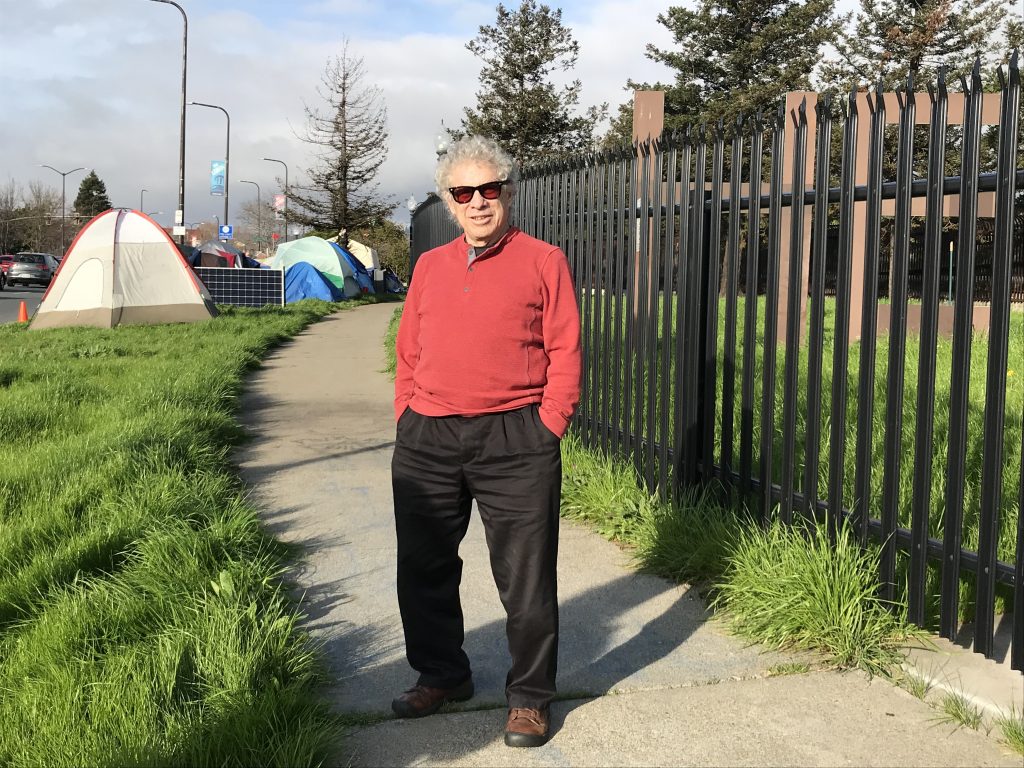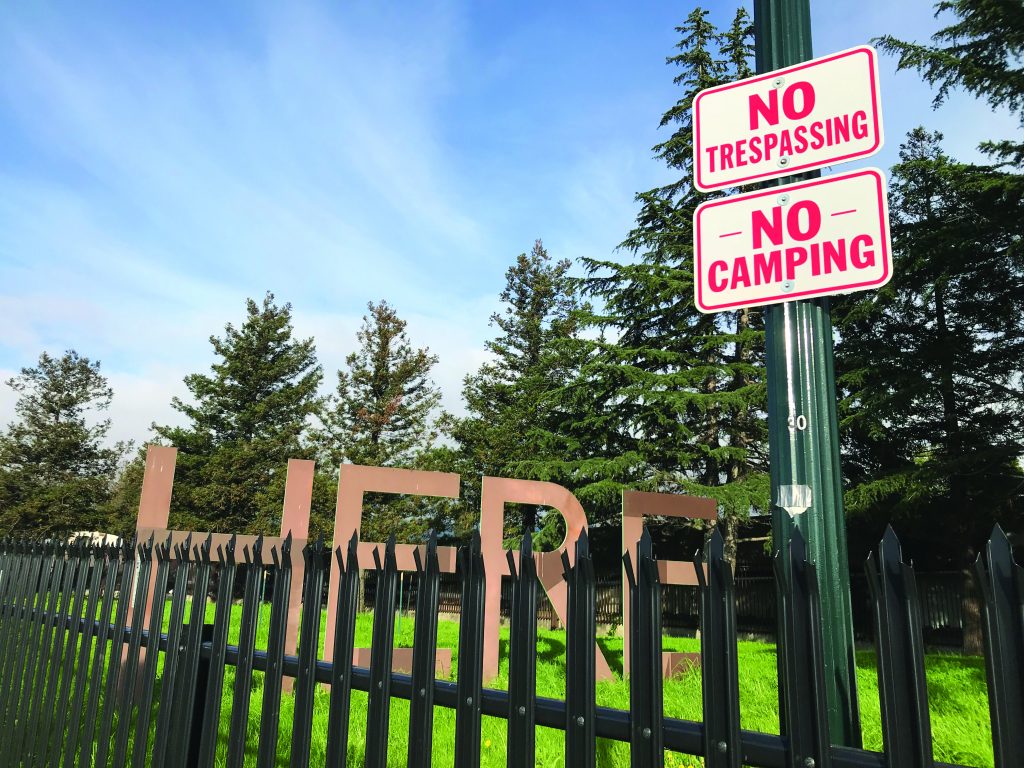
Driving north down Adeline Street, you might notice an eight-foot-tall steel sculpture that reads “Here There” marking the border between Berkeley and Oakland—if you’re paying attention.

The artist behind that sculpture is Steve Gillman, who built it in 2005 after winning a request for proposals (RFP) from the City of Berkeley to make a welcome sign for the city’s south-east border. Gillman’s sculpture—which is a tall cutout of the word “here” facing an equally sized cutout of the word “there”—stood in relative peace until 2017, when BART—which owns the land beneath it—erected a tall, metal fence around the land on which it stands. They did this to thwart a group of homeless people who had begun camping beneath the sculpture. Now, that same encampment has relocated just yards away from the fence to a plot of city-owned land, commonly known in South Berkeley as the “Here There” camp, so named after Gillmans art piece. Meanwhile, the sculpture remains almost entirely obscured from view.
We caught up with Gillman to talk about the fence surrounding his well-known artwork, the encampment that has come to exist beside it, and the role of public art in facilitating important public conversations. (Our conversation has been edited and condensed.)
Alastair Boone: How long have you been in the Bay Area?
Steve Gillman: I’ve lived in West Oakland since 1986. I was living in Oregon before that. I spent a long time in the Bay Area, I went to San Francisco State and I really loved the idea of moving back but I couldn’t afford to live in San Francisco even in ’86. But I did find this place I could buy in West Oakland.
AB: I’ve read that you were inspired by Gertrude Stein’s famous quip about Oakland, that “there’s no there, there.” Is that true?
SG: As I was typing out a cover letter, “Here There” popped into my head. Where that came from, I don’t know. I think it had to do with the fact that Berkeley has a kind of a reputation of rabble rousing and social responsibility. There’s kind of an ego that surrounds the City of Berkeley itself, and the idea of “here” being the center of the universe. I think that was probably more the inspiration than Gertrude Stein. But it wasn’t a few seconds before I realized “oh yeah, Oakland is the ‘there’ of ‘there is no there, there’.” So I proposed it, they liked it. It’s one of the few projects where my initial idea became the final idea. That very seldom happens, if ever.
It’s my understanding that most people think of Stein’s reference of “there’s no there, there” in Oakland being a comment about the lack of culture in Oakland. But in fact, Gertrude Stein was born in Oakland, and became an expatriate and lived in Paris for most of her life. She came back to Oakland at some point because she wanted to see the house that she grew up in, and when she went it was gone. It was replaced by an apartment. And that’s where the inspiration for “there’s no there, there” actually comes from for her.
AB: That’s really interesting. That touches on another theme I wanted to ask you about: How do you feel the current narrative of homelessness in the East Bay fits into Stein’s mythology of “there’s no there, there”?

SG: In some ways you could make a direct link to Stein. Her house is gone, whether it’s there or not, it’s just not accessible to her. And most if not all of these people [living in the encampment] did at some point grow up in a house, live in a house, own a house, and have had it taken away from them for whatever reason. And so their house, whether it’s existing or not, is not available to them. So there is no there, there for all the people who are living here.
AB: In a way it’s impossible to separate the existence of the fence from the homeless crisis in Berkeley, since the fence is BART’s reaction to the fact that there were people camping here. Can you talk a little bit about how you see homelessness contributing to the dialogue initiated by your sculpture?
SG: You put up an artwork, and then the dialogue can happen or not happen, and we’ve just gotta sit back and watch it happen. So I can be academic about it and just say “well, this is a new form of communication.” But that would be sidestepping what’s going on here, which is that it seems as if all government agencies play lip service to “oh we have a homeless problem we have to do something about it,” but nothing happens. And this [fence] is nothing happening in a real, active way. BART has decided that they’re going to solve their homeless problem by not letting homeless people camp on their property, which defies explanation, really.
AB: How do you view the relationship between your sculpture and the encampment that has sprung up next to it?
SG: I remember driving by before the fence was up and seeing the people camped around it, and I had positive thoughts about that. I thought “oh, okay, this is great.” I do work that’s called place-making. And so I’ve made a place here with this piece, then people who are living over there, they also made a place out of this. It’s a different place, but it’s a wonderful place. And it’s part of that dialogue that I’m talking about, where work changes throughout its life.
And Stacey [a resident of the encampment] has mentioned that he made an effort to keep the tents in such a way that people could still see the sculpture, which is way more than I can say for BART, who has gone out of their way to screw it up.
AB: In 2005 when you built the sculpture, were there people camping around this area?
SG: No. No there weren’t.
“You put up an artwork, and then the dialogue can happen or not happen, and we’ve just gotta sit back and watch it happen. So I can be academic about it and just say ‘well, this is a new form of communication.’ But that would be sidestepping what’s going on here, which is that it seems as if all government agencies play lip service to ‘oh we have a homeless problem we have to do something about it,’ but nothing happens.”
AB: What types of dialogue has the “HERETHERE” sculpture helped to facilitate?
SG: When word got out that the city was going to put this sculpture here, there was a whole cry of people in the neighborhood saying “no we can’t have that here, it’s going to bring gangs who are going to have turf wars over ‘here’.” But that kind of died down and it was built, and the next thing that happened was a group of weavers decided that I was dissing Oakland by referring to Oakland as ‘there’, to which I said why would “here” be any better than “there”? There and here in my mind are equivalent. So I’m not really dissing Oakland by saying that that’s where “there” is. In fact I’m saying, “there is a there, there!”
In spite of that, they were hanging onto their belief that there was a denigration, so they weaved a tea cosy which they put over the “T” to hide it, so that it read “here” and “here”. Because the difference between a “here” and a “there” is the T. And the city wanted to tear [the cosy] down. And I said no, don’t tear it down! This is a great dialogue. That’s what public art is about, it’s about dialogue. And that dialogue can take any form. We don’t know what the form is going to be.
AB: Can you give me a play-by-play of what happened with the fence? When did it go up, and what’s the latest?
SG: In 2017, someone called me and said “did you know that there’s a fence up around the sculpture?” And I drove by and looked and there it was. I did go to a city council meeting where they took up the issue, and I know there was a lot of valiant talk about “we’re going to make BART take down the fence” and it’s still here. Sometimes I can work myself up into enough of a concern to think about what I could do as the artist. There is actually an arts preservation law in California that says you can’t change or alter the character of a public art, and this is definitely changing the character of the piece. And I actually went as far as to contact lawyers for the arts, but somehow that never went anywhere.
One of the things that I’ve always done with my artwork is to not put it on a pedestal. This fence is a form of a pedestal. It separates the work rather than allowing it to be a part of the rest of the world. And so it has completely changed. The piece is no longer what it was intended to be, it is no longer what Berkeley bought. And I’m actually surprised that the City of Berkeley hasn’t taken up arms. They spent all this money and they didn’t get what they paid for.
In Dialogue is a column in which Street Spirit speaks with community leaders.
Alastair Boone is the Director of Street Spirit.
